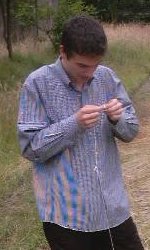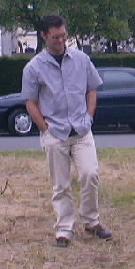
|
Cronicle
- 9 april 2002: our very first steps into the
brave new world of rocket research. In which we totally render useless
our first projectile.
- 23 april 2002: a wine cork is a very nice thing indeed.
- 24 april 2002 Featuring the simplest, lowest-tech
launcher we've seen to date
- 25 april 2002: during the noon we made a video (coming really soon)
- 30 april 2002: we made a new launcher.
- 2 may 2002: we bought a new pump. This one has a manometer that goes up
to 10 bar. During the noon, we did some preliminary tests with
our new toy using the new launcher (the tube was too wide for
the old launcher) and manually.
- 19 june 2002: half a launch is, in fact, of course, no launch at all.
- 4 july 2002: Pieter Audenaert made a new, simpler, better launcher.
- 5 july 2002: More experiments with this launcher.
- 8 july 2002: we add some guidance planks to the launcher
and discover the necessity of a safety cord. Some very good launches though.
- 9 july 2002: more experiments. For some reason today
all launched bottles seem to launch at a tilted angle; we need a system
that keeps the bottle more vertical during the pumping.
In the evening, Geert made yet another new launcher.
- 10 july 2002: We launched one 1.5 liter bottle, so the others could see
the new launcher in action. Alas rainfall prohibited our brave researchers
to conduct more experiments.
- 26 august 2002: Alas, both of our launches failed.
- 27 august 2002: 5 successful launches,
amongst one experiment with fins.
Interesting news: our departement joins the Science Week
(Wetenschapsweek)
in which every day, school students will visit our departement
and this water rocket project will be one of the events organised!
- 30 august 2002: four nice launches
with a new launcher (using the same mechanism as our last one).
We got 6 bar out of our bicycle pump, a new record.
- 2 september 2002: another series of successful
launches.
- 3 september 2002: we try to make a big bottle
out of two small ones.
- 4 september 2002: starring Pieter Vandecasteele's
launcher, and a first parachute test. We also test the big bottle we
made yesterday.
- 5 september 2002: we launch a 2 liter bottle
(which ends up in a tree) and do some more parachuting.
- 6 september 2002: we launch a 1.5 liter, a
2 liter, two 0.5 liter, and again the 1.5 liter bottle to test
the fresh upgrades to Geerts launcher.
- 17 september 2002: a bottle hits our
brave researchers!
- 19 september 2002: introducing the Brick family.
- 20 september 2002: starring an extension to
the launcher.
- 24 september 2002: we launch next to a building,
to get a better idea of the height our bottles reach.
- 21--25 october 2002: during the science week,
we demonstrate our rockets four times (all weekdays except wednesday)
to visiting classes of students.
- 8 november 2002: we learn that the scientific magazine Natuur & Techniek
holds a water rocket contest. This sparks our interest again and
we manufacture a 3 liter bottle using two 1.5 liter bottles and lots
of tape.
On a completely unrelated note: a Google search for
"water rockets" reveals our page on the 13th place! (Our webcounter
reveals that our page was visited 217 times, 71% of the visits
were from Belgium, 17% from the USA.)
- 12 november 2002: we do a test launch with our 2x1.5 silicone rocket;
alas, it still leaks. Nice stable flight though. We decide
to try another system: we fill the joint between the two bottles
with PVC glue.
- 14 november 2002: we test three rockets made of
two bottles each. Alas, we learn that we have not mastered the art
of sealing two bottles together without leaks. Also a test with
a little bottle with fins: at least, this time the fins don't
fly off the rocket one second after liftoff :-)
- 15 november 2002: some glueing experiments.
- 16 november 2002: entering the wonderful world of electronics.
- somewhere end november 2002: testing the prototype electronic circuit, which turns out to be behaving rather strangely.
- 31 march 2003: we try to inflate a balloon inside a compound bottle, since
all our attempts to glue them have failed. It's not as easy as it
sounds: the balloon doesn't move easily inside the bottle, hence
it tends to be thickest to the end where air is applied, and very
thin on the other end till it finally bursts. However, when we put some
soapy water (thanks Joris for the idea!) inside the bottle, we can inflate the balloon fully.
[Some webpage stats: over 1000 hits, about 50% from the US and 30% from Belgium; 26th place on Google.]
- 1 april 2003: we inflate a balloon inside the same compound bottle. This
time, we poured a nice amount of wallpaper glue inside the bottle
and rotated the bottle slowly so that the inside was fully covered
with the glue. Then we inflated the balloon, connected to a hose, so
we could start to inflate the balloon when it was about in the center
of the bottle. Wallpaper glue seems to be even more slippery than
soapy water, the inflating went really smooth! This is probably because
the glue is thicker (more viscuous) than the water, and hence a thicker
film of glue remains between the bottle and the balloon so the balloon
slides better whilst being inflated. When the balloon was fully inflated,
we put a bottle cap on one end (making it almost impossible for the balloon
to shrink on that side) and continued pumping (and also pulling
the tube gently) until the opening of the balloon was fully outside
the bottle. Alas, the next day, the balloon had lost some air
and receded some 10cm. When we tried to pump it up again and gently
pull the end out of the bottle, we heard a loud bang and the balloon
deinflated immediately ... Most of the balloon was intact, but we
learned that the glue had not had much effect.
- 28 april 2003: I fixed a small bug in the electronic circuit
and got the opportunity to test it on a friend's scope. Everything seems
OK.
Note: if your probe has settings "1X", "off" and "10X", *don't* set it in the "off" setting when you
want to test a circuit, and *don't* be surprised that in the "10X" setting, your voltage readings are ten times too low ... :-S
- 25 may 2003: I get an email with another method for glueing bottles together.
- 1 july 2003: finally some progress in the science of bottle-glueing.
[stats: 1670 hits, 60% from the US, 20% Belgian, Google 26th place]
- 2 july 2003: Another 2x2 liter bottle is ready, this time using PVC glue: it has been drying for 24 hours and now it's filled up with water it seems to be watertight,
but we will see what happens after the water has been in it for a whole night. Yesterday's bottle has been filled with water for more than 24 hours and no trace of a leak whatsoever.
Interesting is that the bottle glued with glue for soft plastic is
much more rigid than the bottle with the PVC glue; which one is better
for rocketry remains to be seen.
The electronic beeping circuit appears to be OK (I fixed a few errors).
However, I seem to have damaged the piezo beeper (it beeps but very quietly).
Luckily enough, I have an old PC speaker with which the circuit manages to produce a lot of noise.
The PC speaker is maybe a bit heavy to put in the rocket; I tested
an old headpone and that too produces a loud sound, so maybe we can
dismantle the speakers from them and use those.
- 3 july 2003: the second 2x2 liter bottle (the one with the PVC glue) appears to be good too.
I bought a cheap microphone (a Velleman MIC1BL for 5 euros; 600ohms impedance, -75+/-3dB sensitivity, 100Hz-10kHz frequency response, uni-directional).
The packing mentions in large friendly letters "use for karaoke" :-)
Getting my computer to capture microphone input seems not to work though.
- 4 july 2003: the computer finally captures audio input.
- 6 july 2003: the electronics finally seem to get in an acceptable shape.
- 7 july 2003: we try to pressure test one of the 2x2 liter bottles (the one with PVC glue).
Alas, it almost instantly leaks: with a loud bang, we are left with two
bottle halves. The bottle was not ripped apart; it's only the glue
that did not manage to keep the bottle together. We then reinforced
the remaining 2x2 liter bottle with tape and did another test:
we tested up to a bit less than 2 bar and the bottle withstood the
pressure! Tomorrow we will try a real launch.
- 9 june 2004: we launch two of the 2x2 liter bottles. Alas, one of them
fails to build up enough pressure and stays on the launch pad;
the other did a few flights. However, once the pressure is too high,
the glue cracks and the bottle start to leak a bit, limiting the
pressure we can put on the bottle.
- 13 august 2004: since glueing bottles together does not work,
we try to inflate a condom (instead of a balloon as we tried before)
inside a compound bottle. To get it inside the bottle, we fill
it with a little water. Alas, the lubrication was not optimal
(maybe because we spilt water on it) and the condom bursted open.
On the website of the manufacturer, we read
that the condom can contain 40 liters of air, so it was indeed very
probably a lubrication problem.
Also, we noticed that we have to think about a way to keep the
inflated condom in place, since it has a natural tendency to return
to its original size.
- To be continued ...
Thematical info
|














